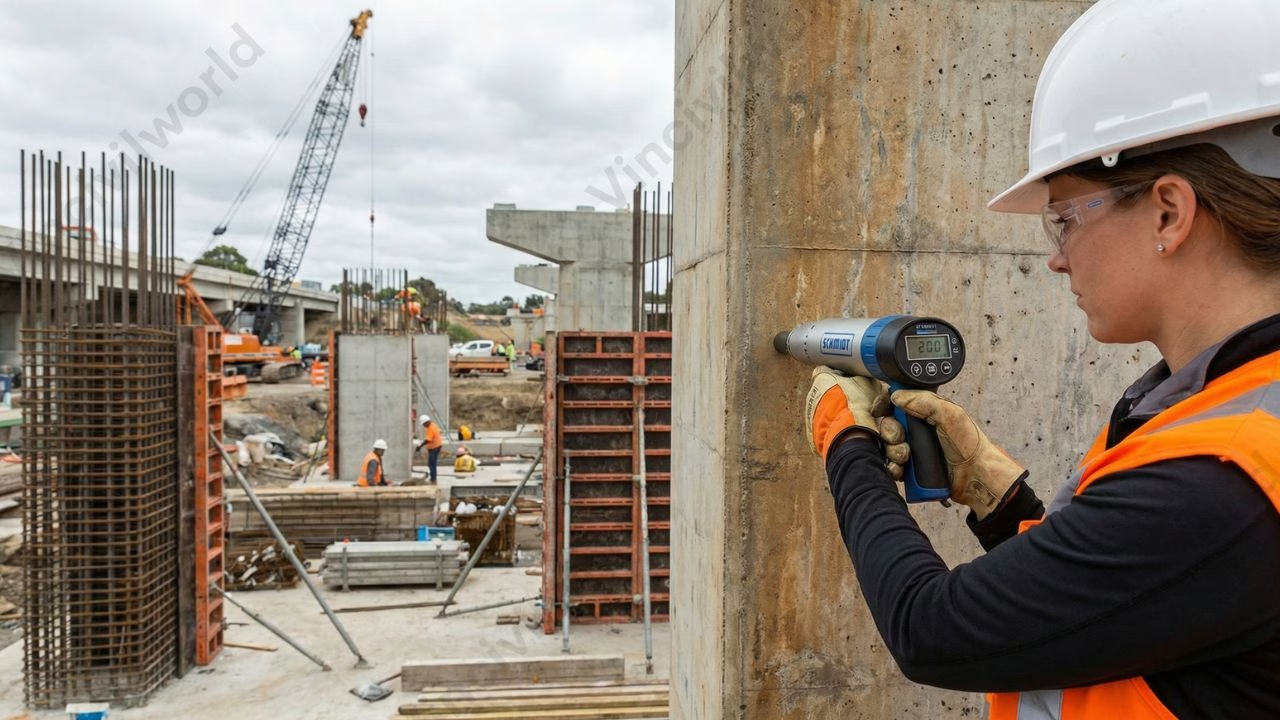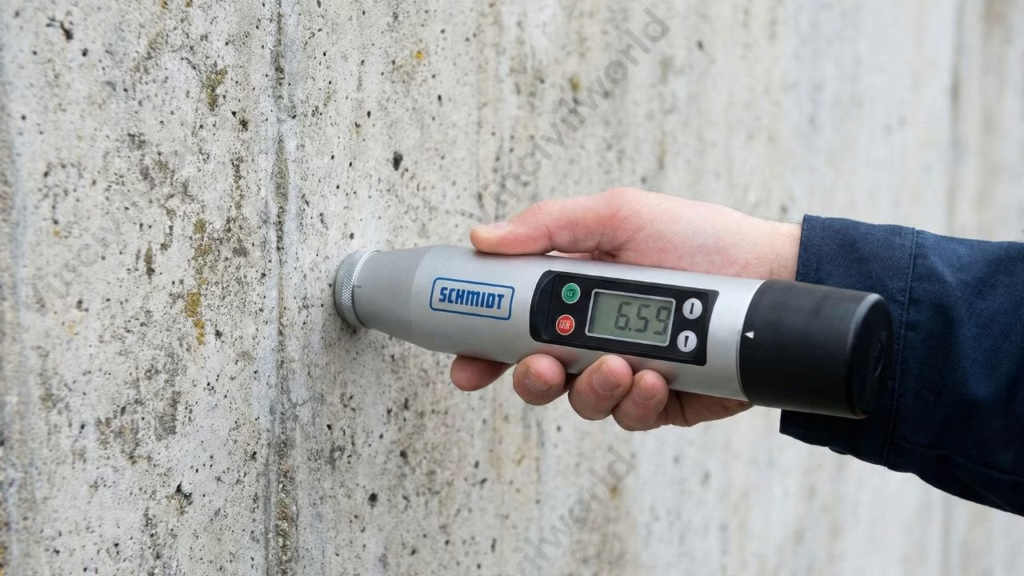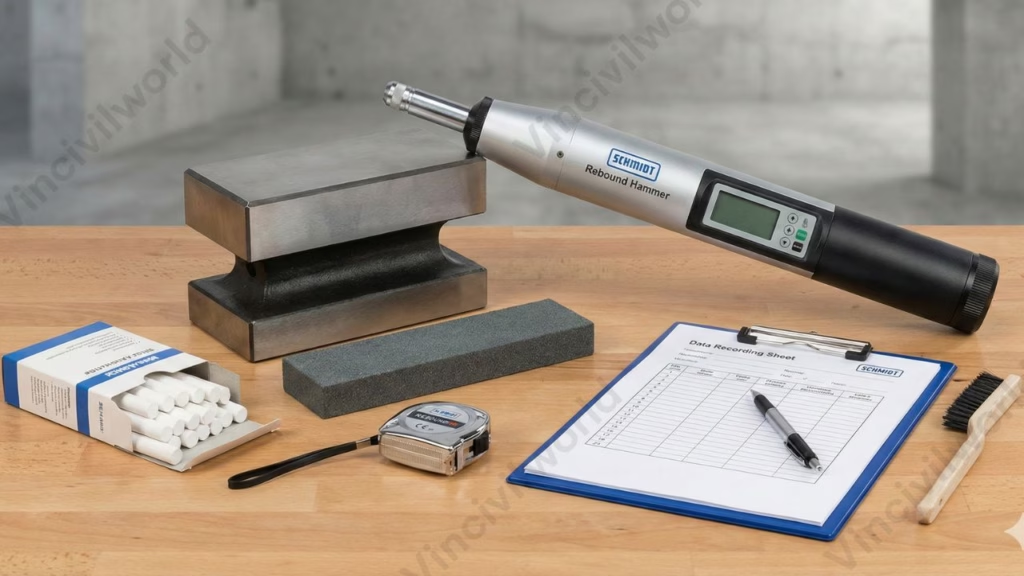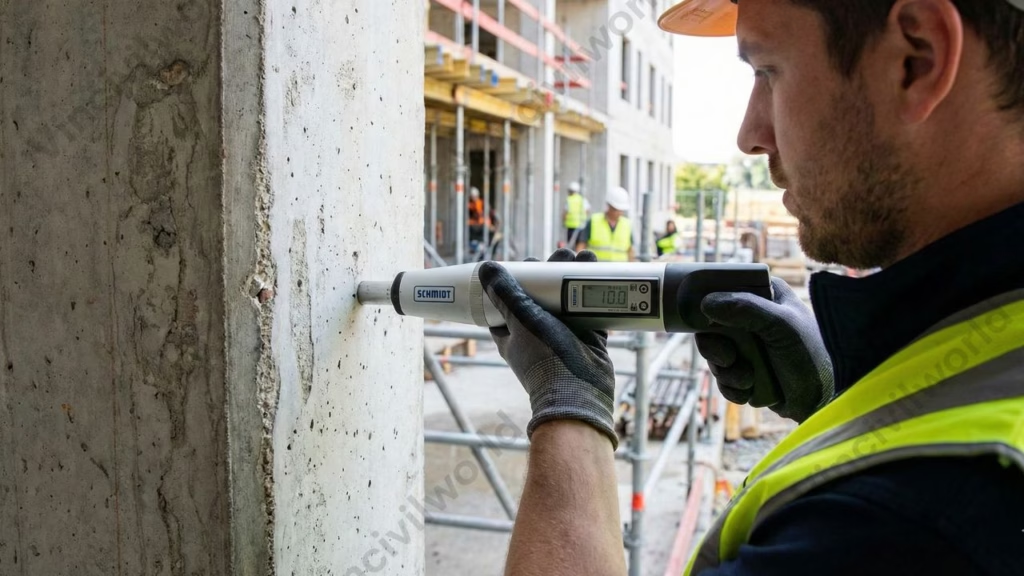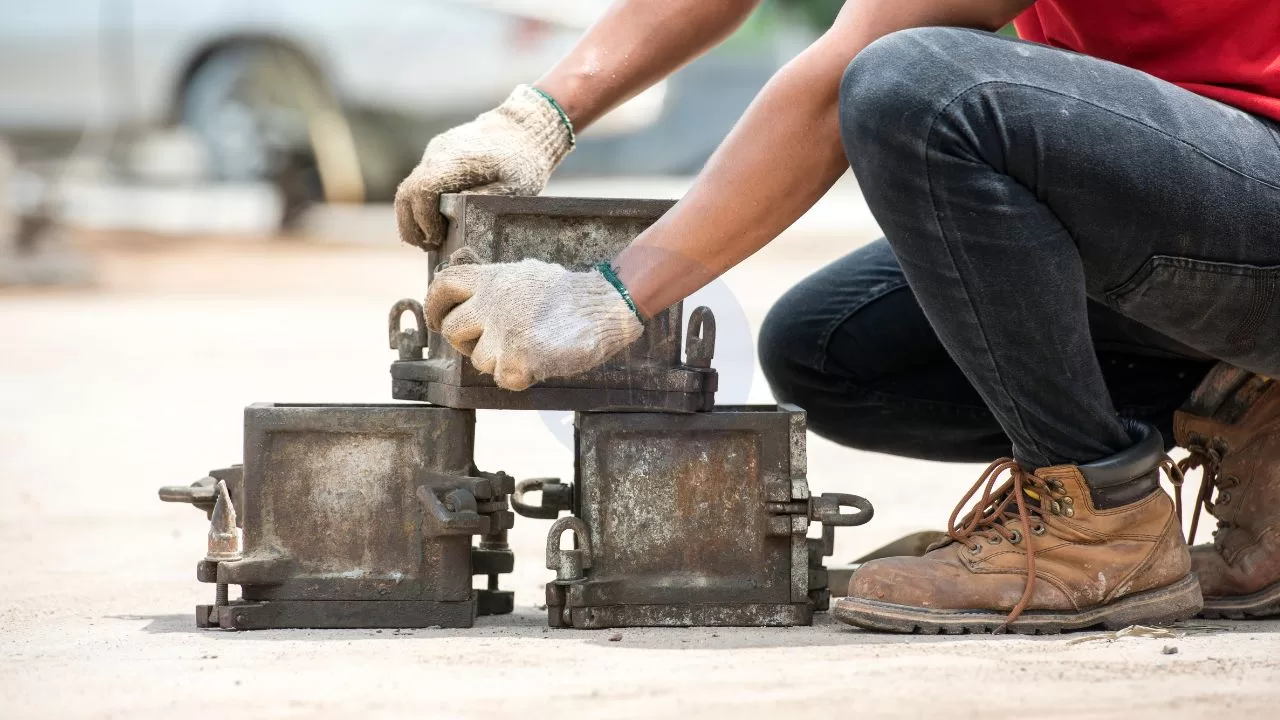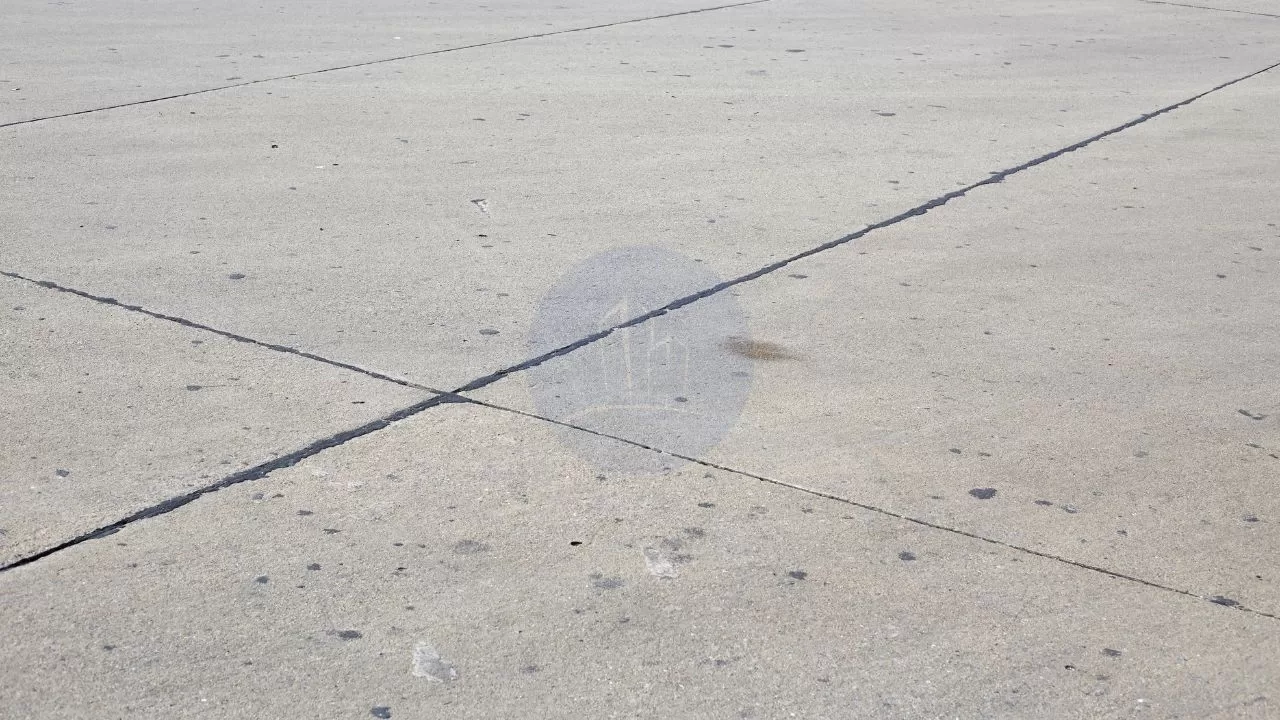Rebound Hammer Test for Concrete is one of the most widely used non-destructive tests to evaluate in-place concrete strength. Also known as the Schmidt Hammer Test, it helps engineers quickly assess concrete surface hardness without damaging the structure. This test measures the rebound number when a spring-controlled hammer impacts the concrete surface, providing valuable insight into its compressive strength. The Rebound Hammer Test procedure is simple, fast, and highly suitable for quality control at construction sites. It is commonly used in buildings, bridges, and existing structures where core extraction is difficult or not recommended. Along with evaluating strength, the method helps identify weaker concrete zones and ensures uniformity. Due to its practical benefits, many professionals prefer this technique while comparing concrete hardness test methods. Understanding the advantages of Rebound Hammer Test ensures accurate decision-making in structural assessment and maintenance.
Rebound hammer test is one of the most popular and simple non-destructive concrete tests. The Non-destructive test is the process of detection of defects in concrete without its destruction. The determination of concrete quality is necessary for both fresh concrete and hardened concrete. The rebound hammer test is the common test for determining quality for existing structures.
Table of contents
- Rebound/Schmidt hammer test definition and significance
- Objectives of Rebound hammer test
- Rebound hammer test procedure – Standard method
- Correlation between compressive strength of concrete and rebound index.
- Result Calculation of Rebound Hammer tests
- Concrete quality and rebound test values
- Advantages of rebound hammer test
- Conclusion
Rebound/Schmidt hammer test definition and significance
The Rebound Hammer Test for Concrete is a widely used non-destructive test for concrete strength that evaluates surface hardness and provides an estimate of compressive strength without damaging the structure. In this Schmidt Hammer Test, a spring-controlled hammer impacts the concrete surface, and the rebound value indicates the concrete’s hardness. This concrete hardness test method is quick, simple, and ideal for assessing uniformity and quality in existing structures. The rebound hammer test procedure helps identify weak zones, monitor deterioration, and ensure proper maintenance. The advantages of rebound hammer test make it essential for preliminary and on-site concrete assessment.
Significance
- Estimates in-place compressive strength of concrete
- Checks surface hardness and material uniformity
- Identifies weak zones or deteriorated areas
- Helps compare different structural members
- Quick, cost-effective, and non-destructive field evaluation
Relevant Codes
| Country / Region | Standard Code | Title / Description |
|---|---|---|
| India 🇮🇳 | IS 13311 (Part 2): 1992 | Non-destructive testing of concrete – Rebound Hammer |
| USA 🇺🇸 | ASTM C805 / C805M | Standard Test Method for Rebound Number of Hardened Concrete |
| Europe 🇪🇺 | EN 12504-2: 2021 | Testing concrete in structures – Part 2: Non-destructive testing – Rebound Hammer |
| International 🌍 | BS 1881: Part 202: 1986 | Testing Concrete – Recommendations for Rebound Hammer Test |
| International 🌍 | ACI 228.1R | In-place Methods to Estimate Concrete Strength (includes rebound hammer guidance) |
Objectives of Rebound hammer test
The main objectives of the Rebound hammer test include
- This determines the compressive strength of the concrete in terms of the rebound index.
- Also finds the uniformity of concrete.
- evaluates the concrete quality with standard requirements.
Rebound hammer test procedure – Standard method
The Rebound Hammer Test for Concrete is a widely used non-destructive test for concrete strength. It measures the surface hardness of hardened concrete to quickly estimate compressive strength using a Schmidt hammer. This test is simple, cost-effective, and provides immediate results on-site. It is an essential method in quality control to check concrete uniformity, detect weak zones, and evaluate structures without causing damage. While the rebound hammer test procedure ensures quick assessment, results must be correlated with laboratory-tested samples for accuracy.
Procedure – Step-by-Step
- Select the test area – Smooth, clean, and free from loose particles or surface defects.
- Hold the rebound hammer firmly and position it perpendicular to the test surface.
- Press the plunger against the concrete until the hammer triggers a rebound.
- Record the rebound number displayed on the scale.
- Perform at least 10 readings on one point and discard abnormal outliers.
- Take the average rebound number for that test location.
- Apply correction factors (surface condition, carbonation, direction of testing).
- Use a correlation chart to estimate compressive strength of concrete.
The correlation between the concrete strength and the rebound hammer shown in a graph is called the rebound hammer graph.
According to IS 13311 (Part 2): 1992, the rebound hammer test requires specific calibration, correction factors, and surface conditions to ensure accurate results in Indian construction environments. IS also recommends correlating rebound numbers with compressive strength based on concrete grade, age, and surface hardness to minimize interpretation errors.
Correlation between compressive strength of concrete and rebound index.
It is essential to calibrate the rebound hammer before testing. For this, we test a specimen of 150mm * 150mm * 150mm size using a compression testing machine (CTM). Fix the load rate at 7N/mm2, when the hammer result is 2.2 Nm. Test the vertical surface of the specimen using a rebound hammer. The results from the CMT and the rebound hammer should not have a major difference.
Result Calculation of Rebound Hammer tests
The Rebound Hammer Test for Concrete measures surface hardness and estimates compressive strength without damaging the structure. The rebound number directly reflects the elasticity of concrete—higher numbers indicate harder and stronger concrete. To calculate results accurately, we take several rebound readings on a smooth, clean surface, remove extreme values, and determine an average. This average rebound number is then compared with calibration charts provided by the hammer manufacturer or relevant standards (IS 13311 Part 2:1992) to determine the estimated compressive strength of concrete at the test location.
The rebound number assess the strength of the structure. As the rebound number increases, the strength also increases. This depends on the
- Cement type
- Aggregate type
- Surface condition
- Age of concrete
- Moisture content, etc.
The quality of concrete concerning the rebound concrete is as follows.
Concrete quality and rebound test values
Thus the rebound number predicts the quality of concrete. The rebound hammer apparatus is very easy to use. Also, it determines the uniformity of the concrete surface. Thus it can be used for the rehabilitation of old monuments. It produces a convenient indication of compressive strength
| Rebound Number Range | Estimated Concrete Quality | Interpretation Notes |
|---|---|---|
| ≤ 20 | Poor / Very Weak Concrete | Possible deterioration, low strength; further testing required |
| 20 – 30 | Fair / Medium Quality Concrete | Acceptable for non-structural sections; verify structural safety using core tests |
| 30 – 40 | Good Quality Concrete | Suitable for reinforced concrete structural elements |
| > 40 | Very Good / Hard Concrete | High strength concrete; ensure carbonation effects are considered |
Advantages of rebound hammer test
The Rebound Hammer Test is one of the simplest and fastest non destructive tests for concrete strength. It allows engineers to quickly assess the surface hardness and uniformity of concrete without damaging the structure.
Key Advantages of Rebound/Schmidt Hammer Test
- Quick and easy testing with instant results
- Completely non-destructive, keeping the structure intact
- Portable and ideal for on-site assessment
- Helps identify weak or deteriorated concrete areas
- Cost-effective compared to laboratory strength tests
- Useful for quality control and comparative analysis
- Can be used on both old and new concrete structures
- Requires only a single operator and minimal training
- Helps decide if further detailed testing (e.g., core cutting or UPV) is needed
- Provides data for concrete hardness evaluation and uniformity checks
Key Takeaways
- The Rebound hammer test for concrete is a widely used non-destructive method to assess concrete strength and surface hardness.
- It involves a spring-controlled hammer that impacts the concrete, measuring the rebound number to estimate compressive strength.
- This test is quick, cost-effective, and essential for quality control, helping identify weak zones and ensuring uniformity in structures.
- Professionals appreciate the test for its practical advantages, including its portability and immediate results on-site.
- Applicable codes include IS 13311 (Part 2) in India and ASTM C805 in the USA, ensuring standard practices across regions.
Conclusion
The Rebound Hammer Test for concrete is a widely used non destructive test for concrete strength, helping engineers quickly check surface hardness and uniformity without damaging the structure. As one of the simplest concrete hardness test methods, it supports quality control, preliminary assessment, and condition monitoring of existing buildings. While rebound values alone do not determine exact compressive strength, they provide valuable onsite insights when combined with other techniques such as UPV or core strength tests. By following the correct rebound hammer test procedure and calibration guidelines, engineers can improve reliability and decision-making. Overall, the Schmidt Hammer Test offers a fast, economical, and practical way to evaluate concrete, enhancing durability, safety, and maintenance planning in modern construction projects.

